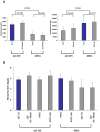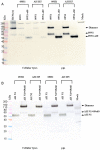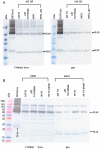Characterization of neuraminidases from the highly pathogenic avian H5N1 and 2009 pandemic H1N1 influenza A viruses
- PMID: 21209916
- PMCID: PMC3012118
- DOI: 10.1371/journal.pone.0015825
Characterization of neuraminidases from the highly pathogenic avian H5N1 and 2009 pandemic H1N1 influenza A viruses
Abstract
To study the precise role of the neuraminidase (NA), and its stalk region in particular, in the assembly, release, and entry of influenza virus, we deleted the 20-aa stalk segment from 2009 pandemic H1N1 NA (09N1) and inserted this segment, now designated 09s60, into the stalk region of a highly pathogenic avian influenza (HPAI) virus H5N1 NA (AH N1). The biological characterization of these wild-type and mutant NAs was analyzed by pseudotyped particles (pseudoparticles) system. Compared with the wild-type AH N1, the wild-type 09N1 exhibited higher NA activity and released more pseudoparticles. Deletion/insertion of the 09s60 segment did not alter this relationship. The infectivity of pseudoparticles harboring NA in combination with the hemagglutinin from HPAI H5N1 (AH H5) was decreased by insertion of 09s60 into AH N1 and was increased by deletion of 09s60 from 09N1. When isolated from the wild-type 2009H1N1 virus, 09N1 existed in the forms (in order of abundance) dimer>>tetramer>monomer, but when isolated from pseudoparticles, 09N1 existed in the forms dimer>monomer>>>tetramer. After deletion of 09s60, 09N1 existed in the forms monomer>>>dimer. AH N1 from pseudoparticles existed in the forms monomer>>dimer, but after insertion of 09s60, it existed in the forms dimer>>monomer. Deletion/insertion of 09s60 did not alter the NA glycosylation pattern of 09N1 or AH N1. The 09N1 was more sensitive than the AH N1 to the NA inhibitor oseltamivir, suggesting that the infectivity-enhancing effect of oseltamivir correlates with robust NA activity.
Conflict of interest statement
Figures







Similar articles
-
[Virological impact of stalk region of neuraminidase in influenza A/Anhui/1/05 (H5N1) and A/Ohio/07/2009 (H1N1) viruses].Bing Du Xue Bao. 2014 May;30(3):238-45. Bing Du Xue Bao. 2014. PMID: 25118377 Chinese.
-
Characterization of pseudoparticles paired with hemagglutinin and neuraminidase from highly pathogenic H5N1 influenza and avian influenza A (H7N9) viruses.Virus Res. 2018 Jul 15;253:20-27. doi: 10.1016/j.virusres.2018.05.024. Epub 2018 May 31. Virus Res. 2018. PMID: 29859234
-
Antiviral susceptibility of avian and swine influenza virus of the N1 neuraminidase subtype.J Virol. 2010 Oct;84(19):9800-9. doi: 10.1128/JVI.00296-10. Epub 2010 Jul 21. J Virol. 2010. PMID: 20660186 Free PMC article.
-
Recent advances in neuraminidase inhibitor development as anti-influenza drugs.ChemMedChem. 2012 Sep;7(9):1527-36. doi: 10.1002/cmdc.201200155. Epub 2012 Jul 16. ChemMedChem. 2012. PMID: 22807317 Review.
-
Laninamivir octanoate: a new long-acting neuraminidase inhibitor for the treatment of influenza.Expert Rev Anti Infect Ther. 2011 Oct;9(10):851-7. doi: 10.1586/eri.11.112. Expert Rev Anti Infect Ther. 2011. PMID: 21973296 Review.
Cited by
-
Molecular characterization of the surface glycoprotein genes of highly pathogenic H5N1 avian influenza viruses detected in Iran in 2011.Trop Anim Health Prod. 2014 Mar;46(3):549-54. doi: 10.1007/s11250-013-0528-7. Epub 2014 Jan 5. Trop Anim Health Prod. 2014. PMID: 24389885
-
Reliability of pseudotyped influenza viral particles in neutralizing antibody detection.PLoS One. 2014 Dec 1;9(12):e113629. doi: 10.1371/journal.pone.0113629. eCollection 2014. PLoS One. 2014. PMID: 25436460 Free PMC article.
-
Preparation and characterization of monoclonal antibodies against VSTM1.Monoclon Antib Immunodiagn Immunother. 2013 Aug;32(4):283-9. doi: 10.1089/mab.2012.0119. Monoclon Antib Immunodiagn Immunother. 2013. PMID: 23909423 Free PMC article.
-
Scotomas in molecular virology and epidemiology of hepatitis C virus.World J Gastroenterol. 2013 Nov 28;19(44):7910-21. doi: 10.3748/wjg.v19.i44.7910. World J Gastroenterol. 2013. PMID: 24307785 Free PMC article. Review.
-
Protection against a lethal H5N1 influenza challenge by intranasal immunization with virus-like particles containing 2009 pandemic H1N1 neuraminidase in mice.Virology. 2012 Oct 10;432(1):39-44. doi: 10.1016/j.virol.2012.06.003. Epub 2012 Jun 22. Virology. 2012. PMID: 22727831 Free PMC article.
References
-
- Horimoto T, Kawaoka Y. Influenza: lessons from past pandemics, warnings from current incidents. Nat Rev Microbiol. 2005;3:591–600. Review. - PubMed
-
- Knipe DM, Howley PM. Field Virology, fifth ed. Lippincott Williams & Wilkins Immunology 2007
-
- Palese P. Influenza: old and new threats. Nat Med. 2004;10:S82–87. Review. - PubMed
-
- WHO. Pandemic (H1N1) 2009. http://www.who.int/csr/don/2010_04_30a/en/. Accessed on 30 April, 2010.
-
- WHO. Confirmed Human Cases of Avian Influenza A(H5N1). http://www.who.int/csr/disease/avian_influenza/country/en/. Accessed on 21 April, 2010.
Publication types
MeSH terms
Substances
LinkOut - more resources
Full Text Sources
Medical

